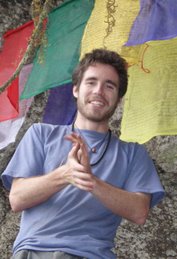 Some of the Khari nuns with their beautiful potted flowers.
Some of the Khari nuns with their beautiful potted flowers.As some of you know, I have been doing some side work importing Tibetan Buddhist prayer flags, Incense and fabrics to New Orleans from India and Nepal in order to raise money for various social work projects in those countries. Besides over $1000 that I've been able to raise for the Louisiana Himalaya Association to support its sister organization Lha Charitable Trust in Dharamsala, India (which I will be writing an update about soon), with the help of some friends at Tibet Association of Tulane University, I was recently able to deliver $300 to to manager of the Khari Nunnery in Nepal.
The Khari Ganden Tenphel Ling Nunnery is perched above Tramo, a small Sherpa village in Khumbu, the Mt. Everest region of Nepal, two days walk from the Tibetan border. All of nunnery's thirty-five ordained Buddhist nuns, ranging from ages twelve to ninety, were born in relative poverty in Tibet. They abandoned their homeland in order to study and practice Buddhism in a safe environment free from the restrictions and fear-mongering of the Chinese Communist Party. In the last two decades the number of nuns there has doubled, and they expect many more young women to flee the recent brutality of the Chinese government to become nuns. Since 2002, the Khari nuns have been engaged in a massive effort to rebuild their nunnery in order to suit the needs of their growing community. Work on a one-hundred person capacity prayer hall is set to be finished next year, after which they will begin building a new kitchen, classroom, toilet facilities, and living quarters.
During the warm dry spring and autumn months, the able-bodied nuns work hard construction labor: breaking rocks into gravel; digging; carrying sand, concrete, and stones; sanding; packing earth; and so on. During the rainy monsoon and frigid winter months many nuns shut themselves away for solitary meditation retreats. When they are able, they make rounds through the neighboring villages begging alms to raise money for the construction and personal expenses.
Starting two years ago, the nuns have had the unique opportunity to begin regular academics for two months each winter. One Geshe (Tibetan Doctorate in Buddhist Philosophy) has been teaching the nuns Buddhist philosophy, another Geshe has been instructing them in Tibetan language and grammar, and a lay Tibetan woman educated in India has been teaching English. They intend on continuing in this way until their building projects are complete, at which time they will begin studying year-round. This is very rare, considering that the vast majority of Tibetan Buddhist nuns never study any philosophy, and most monks in high mountain areas never have the opportunity to study philosophy, either.
The Khari nuns humbly request all those who are able to support their ambitious future plans to donate whatever they are able. They continuously make prayers and aspirations for the sake of world peace and the happiness of all beings, and specifically for those that find the generosity to support their noble endeavors.
 The Khari nuns during the June 2005 Nyungnay fasting retreat at the Lawudo Gompa above their nunnery.
The Khari nuns during the June 2005 Nyungnay fasting retreat at the Lawudo Gompa above their nunnery.I have also worked on a forthcoming book on the modern history of the Khari Nunnery, which has been published in an abridged form by Buddhist Himalaya last year. More information on the Khari nuns can be found at the Tibetan Nuns Project and the Mountain Institute's Sacred Sights of the Khumbu Region (page 6).
 The late Sangye Thinley (at left) with his niece and great niece, both of whom are nuns at Khari.
The late Sangye Thinley (at left) with his niece and great niece, both of whom are nuns at Khari.


No comments:
Post a Comment